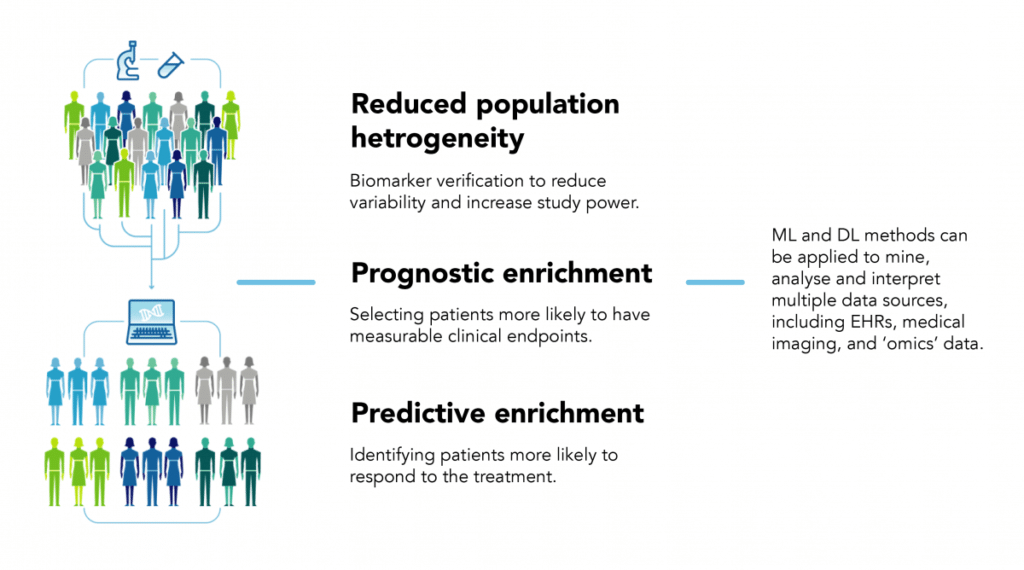AI in the pharmaceutical industry
Drug discovery and development
Bringing a new pharmaceutical product to market is a lengthy process with many bottlenecks. Tests regularly fail to meet their objectives, which can cause delays and increase the cost of an already expensive process. In situations such as the current corona crisis, where a virus spreads rapidly, it is important to obtain accurate results quickly to accelerate drug development.
Various AI applications are therefore being used in drug development. This uses data from viruses that are similar in structure, for example. That data provides insight into the effect of certain drugs in treating patients with a similar virus. For example, Google’s sister company “DeepMind” has used AI to discover patterns about the coronavirus to accelerate the development of a vaccine. Deepmind uses an AlphaFold system to make structure predictions of several differentially studied proteins associated with SARS-CoV-2. These predictions have not been experimentally verified, but they may help scientists understand how the coronavirus works. This may be useful for the development of a working vaccine. Understanding these still unknown proteins normally takes months. But by applying AI algorithms, a prediction based on structure of similar proteins can be made much earlier.
Selection of patients for clinical trials
Bringing a new drug to market takes between 10 and 15 years on average. About half of this time and additional costs are spent on clinical trials. This makes conducting clinical trials often the most costly phase of drug development. As a result, researchers want to be sure of the proper selection of patients for a given study. Despite significant investment, clinical trials still have a low success rate and failure is mainly due to imprecise selection techniques and failure to effectively monitor patients. AI can help improve these processes to increase clinical trial success rates. For example, AI applications exist that are able to reduce heterogeneity within a population, leaving those patients who respond better to treatment. Remote patient monitoring helps track patient behavior in clinical trials and identify potential side effects on medications. This can predict potential patient attrition. AI is also being used to select a niche patient population in order to reduce costs.

Improve accuracy of diagnoses
When a new pandemic strikes, it is difficult to diagnose individuals. Large-scale testing is complicated and often expensive. Many people who show symptoms of COVID-19 worry about whether they have contracted the virus, even if those symptoms point to possibly milder diseases. The use of AI can play an important role in diagnosing diseases. A Florida hospital was one of the first to attract attention by using this in the diagnosis of COVID-19. Upon entering the hospital, patients receive an automatic face scan in which machine learning detects whether or not they have a fever.
A recent study found that 12 million adult patients in the United States are misdiagnosed each year and 10% of deaths are due to diagnostic errors. By harnessing the power of big data and analytics, healthcare providers can improve diagnostic accuracy and reduce mortality. Many data analytics companies today offer solutions using innovative data science techniques and machine learning algorithms to improve diagnostic accuracy. These predictive techniques analyze historical data such as patient data, symptoms, habits, diseases and genome structure to provide an accurate prediction.
Source: Deloitte Analysis
Improved medication prescriptions
It is important for pharmacists to understand the frequency of incorrect prescriptions. With the help of AI, risks of prescribed drugs can be reduced. When a drug is prescribed to a patient, AI applications can recognize patterns in historical data. This alerts physicians to deviations from standard treatment procedures. This helps the healthcare provider improve health outcomes and prevent complications associated with incorrect prescriptions. In addition, clustering and scoring models can be used to determine which treatment or medication is recommended for patients based on historical outcomes and treatment course success rates.
Predicting drug stock in pharmacy
According to the Royal Dutch Society for the Advancement of Pharmacy (KNMP), drug shortages are becoming more common. In 2018, there was a shortfall in 769 drugs. In 2019, this number had nearly doubled to 1,492. The shortage may be caused by problems in production, distribution or other economic reasons. In addition, there may be more demand for specific medications in certain seasons/periods. The demand of these cannot always be accurately estimated resulting in supply shortages. Still, how can we ensure that pharmacies are better prepared for certain uplift/downlift events? And how do we ensure that in such times supplies can better meet demand?
KNMP Farmanco contains information on national drug shortages and historical data from pharmacies. Using this data, we can begin to look for certain patterns and correlations in the data that can help predict the demand for medication. There is a lot of useful information in the historical data. Consider the hay fever season where the peak is in May and June. Therefore, during this period you are most likely to experience symptoms of hay fever and people are more likely to go to the pharmacy for hay fever medication. Using machine learning algorithms, trends can be found quickly. This also applies to non-seasonal disease states, where it is possible to predict which drug will be dispensed most frequently at what time. These results can then be made transparent to pharmacies. This can be implemented in the existing environment, allowing for more accurate medication procurement.
Natural Language Processing on text data
The ability of a computer program to understand a human language is called Natural Language Processing (NLP). One of the most well-known products that uses NLP is “Siri,” Apple’s virtual assistant. Siri uses NLP techniques to translate speech into commands (speech recognition) to navigate on the phone.
But where does NLP actually fit in the healthcare sector? There is an awful lot of data that is being collected in healthcare. For example, through SPDs, reviews and other sources. Since the healthcare industry has begun to adopt advanced technologies, a huge amount of data has been collected. But how can we start putting this data to good use?
That’s where NLP comes in. There is a lot of data at the pharmacy and health insurance companies. By performing topic/sentiment analysis on, for example, patient reviews about pharmacies or customers about health insurers, it is possible to find out what is perceived positively and/or negatively.This insight can improve the service of the pharmacy and the health insurer, resulting in an increase in customer satisfaction. Additionally, we are in the age of social media: just one negative post about a drug’s malfunction can cause a pharmaceutical company to face a lawsuit. NLP and other AI algorithms are used today to quickly discover patterns and relationships in social media, local news reports and measurement data, for example. By “scrapping” early warning signals from the Internet, the pharmaceutical industry can make better choices when it comes to their safety information, thus avoiding potential backlash and risks associated with it.
What solutions are of interest to you?
Right now, the healthcare industry is in the thick of the fight against corona. This crisis has accelerated the use of Artificial Intelligence, wearables and innovative healthcare apps. The examples in this article illustrate only some of the possibilities. If this article has piqued your interest, we would love to get in touch to exchange views, inspire and explore which AI solutions are impactful and relevant to you! We create the future for and with you!




